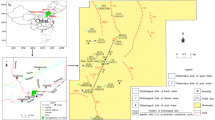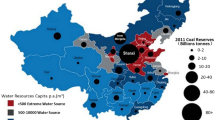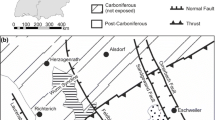Abstract
To ensure safe mining of the 3153 working face in the Chengzhuang mine, with its thin aquifuge, we developed a complete set of methods, including transient electromagnetics, drilling, a water injection experiment, and a numerical simulation based on a new constitutive model. Thus, the groundwater distribution, the aquifuge thickness, and the floor damage thickness were obtained successively and the results from each method could be mutually verified. The main results were: (1) The floor damage thickness decreases when the backfill affects the floor, and further thickens as the hanging roof area increases. (2) Under cyclic loading, tension and compression damage zones are connected. The deepest compression damage lags the coal wall, while the point of maximum tensile damage lags the deepest compression damage zone, thus forming an inclined water-conductive zone.
Zusammenfassung
Um einen sicheren Abbau vom Abbaustoß 3153 in der Chengzhuang-Mine mit ihrem geringmächtigen Grundwassernichtleiter zu ermöglichen, wurde eine Reihe an Methoden entwickelt, die neben Transienten Elektromagnetik, Bohrungen und Experimenten zur Wasserverpressung auch eine numerische Simulation basierend auf einem neuen konstitutiven Modell umfassten. Auf diese Weise konnte die Grundwasserverteilung, die Mächtigkeit des Grundwassernichtleiters und die Ausdehnung von Sohlschäden sukzessive ermittelt und die Ergebnisse der einzelnen Methoden gegenseitig verifiziert werden. Die Hauptergebnisse waren: (1) Die Ausdehnung von Sohlschäden nimmt ab, wenn der Versatz die Sohle beeinträchtigt und nimmt mit zunehmender Fläche der ungestützten Decke weiter zu. (2) Bei zyklischer Belastung besteht eine Verbindung zwischen durch Spannung oder Druck verursachten Schadenszonen. Die tiefste Druckverformung folgt der Kohlefront, während der Punkt maximalen Zugschadens der tiefsten Druckverformungszone nachfolgt, wodurch eine geneigte wasserleitende Zone gebildet wird.
Resumen
Para garantizar la extracción segura de la cara de trabajo 3153 en la mina Chengzhuang, con su delgada acuífuga, desarrollamos un conjunto completo de métodos, que incluyen electromagnetismo transitorio, perforación, un experimento de inyección de agua y una simulación numérica basada en un nuevo modelo constitutivo. Así, la distribución del agua subterránea, el espesor del acuífero y el espesor del daño del piso se obtuvieron sucesivamente y los resultados de cada método se pudieron verificar mutuamente. Los principales resultados fueron: (1) El espesor del daño en el piso disminuye cuando el relleno afecta el piso y se vuelve más grande a medida que aumenta el área del techo colgante. (2) Bajo carga cíclica, las zonas de daño de tensión y compresión están conectadas. El daño de compresión más profundo se retrasa en la pared de carbón, mientras que el punto de máximo daño a la tracción queda retrasado en la zona de daño de compresión más profunda, formando así una zona inclinada de conducción de agua.
成庄矿(中国)3153工作面煤层底板隔水层较薄,为保障安全产,建立了一套安全防治水方法,包括瞬变电磁、钻探、注水试验和基于新结构模型的数值模拟方法。该套方法可以连续获取地下水分布、隔水层厚度和底板破坏深度,各方法之间相互验证。主要结论:(1) 当充填影响到底板时,底板破坏带厚度减少;当悬顶面积增大时,底板破坏带厚度增大;(2)在周期来压作用下,拉张和压缩破坏区相连。最深压缩破坏落后于煤壁,而最大拉张破坏点又落后于最深压缩破坏区,这样形成了倾斜的导水区。












Similar content being viewed by others
References
Cheng YM, Wang JA, Xie GX, Wei WB (2010) Three-dimensional analysis of coal barrier pillars in tailgate area adjacent to the fully mechanized top caving mining face. Int J Rock Mech Min Sci 47:1372–1383
Feng MM, Mao XB, Zhu QH (2010) Effect of lithologic association of the water-resisting strata in coal seam floor on water insulating. J Min Safe Eng 27:404–409 (in Chinese and abstract in English)
Guo H, Adhikary DP, Craig MS (2009) Simulation of mine water inflow and gas emission during longwall mining. Rock Mech Rock Eng 42:25–51
Hu XW, Zhang PS, Yan JP, Guo LQ (2014) Improvement of means for interpretation of advanced water detection of tunnels by transient electromagnetic method. Chin J Geotech Eng 36:654–661 (in Chinese and abstract in English)
Lee J, Fenves GL (1998) Plastic-damage model for cyclic loading of concrete structures. J Eng Mech 124:892–900
Li L, Zhou Z, Li S, Xue Y, Xu Z, Shi S (2015) An attribute synthetic valuation system for risk assessment of floor water inrush in coal mines. Mine Water Environ 34:288–294
Li Z, Feng G, Zhai C (2016a) Study on “triangle” water-inrush mode of strong water-guide collapse column. J Cent South U 23:2402–2409
Li HL, Bai HB, Ma D, Xu J, Qian HW, Tian CD (2016b) Experimental study on mining-induced failure depth lagging coal wall secondary deepening rule. J Min Safe Eng 33:318–323 (in Chinese and abstract in English)
Lu YL, Wang LG (2015) Numerical simulation of mining-induced fracture evolution and water flow in coal seam floor above a confined aquifer. Comp Geo 67:157–171
Lubliner J, Oliver J, Oller S, Onate E (1989) A plastic-damage model for concrete. Int J Solids Struct 25:299–326
Ou S, Wang L, Wang P (2013) Numerical analysis of seepage flow characteristic of collapse column under the influence of mining. Int J Min Sci Technol 23:237–244
Wu Q, Fan S, Zhou W, Liu S (2013) Application of the analytic hierarchy process to assessment of water inrush: a case study for the no. 17 coal seam in the Sanhejian Coal Mine, China. Mine Water Environ 32:229–238
Yin SX, Zhang J (2005) Impacts of karst paleo-sinkholes on mining and environment in northern China. Environ Geol 48(8):1077–1083
Zhang HW, Xiao M, Fan GB (2008) Stress-damage-seepage coupling analysis of surrounding rock of large-scale underground caverns. Rock Soil Mech 29:1813–1818 (in Chinese and abstract in English)
Zhang PS, Yan W, Zhang WQ, Shen BT, Wang H (2016) Mechanism of water inrush due to damage of floor and fault activation induced by mining coal seam with fault defects under fluid-solid coupling mode. Chin J Geotechn Eng 38:877–889 (in Chinese and abstract in English)
Zhu WC, Wei CH (2011) Numerical simulation on mining-induced water inrushes related to geologic structures using a damage-based hydromechanical model. Environ Earth Sci 62:43–54
Zhu QH, Feng MM, Mao XB (2008a) Numerical analysis of water inrush from working-face floor during mining. J Chin Univ Min Technol 18:159–163
Zhu SY, Jiang ZQ, Hou HL, Xiao WG, Yao P (2008b) Analytical model and application of stress distribution on mining coal floor. J Chin Univ Min Technol 18:13–17
Acknowledgements
The authors sincerely thank Mr. Wang Qiang at Southeast University for providing work stations and related data access. This work was supported by the Research Innovation Program for College Graduates of Jiangsu Province (KYLX16_0537) and the National Natural Science Foundation of China (51704280). We also thank the anonymous referees for their careful reading of this article and valuable suggestions.
Author information
Authors and Affiliations
Corresponding author
Electronic supplementary material
Below is the link to the electronic supplementary material.
Rights and permissions
About this article
Cite this article
Li, H., Bai, H., Wu, J. et al. A Set of Methods to Predict Water Inrush from an Ordovician Karst Aquifer: A Case Study from the Chengzhuang Mine, China. Mine Water Environ 38, 39–48 (2019). https://doi.org/10.1007/s10230-018-00572-3
Received:
Accepted:
Published:
Issue Date:
DOI: https://doi.org/10.1007/s10230-018-00572-3




